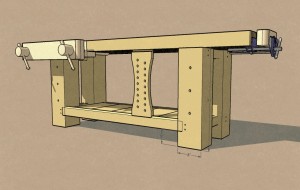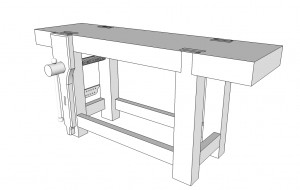We may receive a commission when you use our affiliate links. However, this does not impact our recommendations.
Jacques writes: I have your workbench book, and I am currently working on my version of the French bench. I had soft maple cut down from my woods, so I had it sawn, and I am working with it for the top.
For the legs, a friend of mine gave me four beams that are about 9″ x 9″, out of some resinous wood. They are cracked and dry (must be about 60 years old).
The question I have is: Can I make the legs too big? I was planning to cut them down to 6×6 but, to save a lot of work, is 8×8 a good idea? I know it would add mass and stability to the bench, but having only 8″ between the legs seems to be a little over the top…
Answer: A.J.-Roubo specifies that legs should be 3” to 4” thick x 6” wide (though in the plate they look more square to me).
The legs of the bench are of hard oak, very firm, 6 thumbs in width by 3-4 in thickness. They are assembled on top by tenon and a dovetailed tenon in the style of a slip joint/bridle joint.
I think the only real danger of making the legs 8×8 would be that you would add a lot of work when cutting the dovetail and tenon. The joints would have to be a lot bigger or you would have to remove a lot of wood from the tenon.
My gut says it would be easier to plane down the legs than do the extra joinery work.
Second, I think they would look weird. A guy sent me photos of a bench he had made using 2x8s for both the top and legs. It did not look right. That is probably because of what I am used to seeing on a bench, so take that with a grain of salt.
— Christopher Schwarz
You can buy a copy of my first book “Workbenches: From Design & Theory to Construction & Use” (Popular Woodworking) here at ShopWoodworking.com.
Here are some supplies and tools we find essential in our everyday work around the shop. We may receive a commission from sales referred by our links; however, we have carefully selected these products for their usefulness and quality.












There’s more than one way
to trim a leg
http://blueoakblog.files.wordpress.com/2014/02/dsc08466.jpg
http://blueoakblog.wordpress.com/
If the tenons at the top of the legs are very wide they may become slightly loose as the wood expands/retracts. If I were to make such wide feet I would make sure the tenons are about the size of tenons on 5″ to 6″-wide feet.
I sometimes use holdfasts in my front legs. If this is a possibility for you then 8 inches would be too thick for them to work properly (though you could counter-bore from the rear to reduce effective thickness).
I’d be tempted to saw the lumber into 8″ x 4″ and use the extra soft maple on a project. Or leg a second bench….
The legs of my bench are approximately 7″ x 7″ for the same reason. I didn’t have access to a power jointer/planer/bandsaw and the wood was ash so I had no desire to reduce the legs in size. It ended up looking a little odd on an 8′ bench but I have gotten used to and now “normal” legs look spindly.
Chris is right in suggesting that it is a pain in the behind to cut the mortise and dovetail for the top. It was still easier than trying to remove a huge quantity of wood to thin the legs.
One advantage of stupidly large legs is you get several sizable areas of your bench that are basically solid posts to the ground for chopping over.